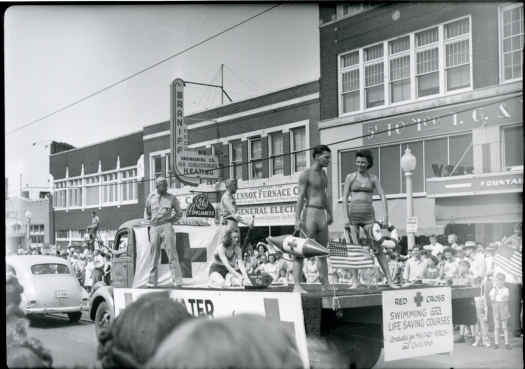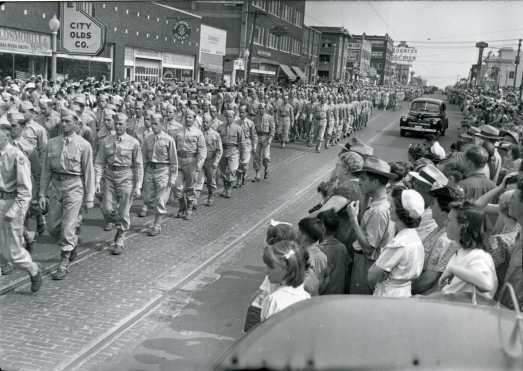WORLD WAR II.
Oklahoma was still mired in economic depression on September 1, 1939, when Germany invaded Poland, igniting World War II. Six years of Pres. Franklin D. Roosevelt’s New Deal had provided assistance to Oklahomans but had not produced prosperity. The next six years of worldwide conflict freed the Sooner State from the grip of the Great Depression and produced change on a scale seldom equaled in American history.
Oklahoma’s fiscally conservative governor, Leon C. “Red” Phillips (1939–43), who had opposed many New Deal measures, could expect few favors from President Roosevelt. Nevertheless, Oklahoma community leaders and chambers of commerce successfully lobbied federal officials for a share of defense spending. Even before the United States entered the war, federal dollars poured into the state for training pilots, establishing military installations, and constructing wartime production facilities. The Selective Service Act of 1940 reduced unemployment and eventually placed so many men in uniform that women entered the work force in unprecedented numbers.
After the Japanese attack on Pearl Harbor on December 7, 1941, almost fifty-five hundred Oklahomans gave their lives in the fight against fascism. Nineteen received Congressional Medals of Honor, and Oklahoma Generals Clarence Tinker and Raymond S. McLain and Admirals J. J. “Jocko” Clark and Marc A. Mitscher commanded major army and navy formations. Oklahomans took pride in all their men and women in uniform, but they felt a special attachment to a National Guard unit drawn from Oklahoma, Colorado, New Mexico, and Arizona. Called to federal service in 1940 under the command of Maj. Gen. William S. Key, the Forty-fifth Infantry Division sailed for the Mediterranean in June 1943 to participate in the invasion of Sicily. The men fought for 511 days, captured more than 120,000 prisoners, and suffered 3,650 combat deaths. They participated in eight campaigns and made three additional amphibious landings, at Salerno and Anzio in Italy and on the Mediterranean coast of southern France. Eight members of the division earned Congressional Medals of Honor. Ironically, in 1938 the thunderbird replaced the swastika as the division insignia. Both symbols reflected the American Indian heritage of the four states whose citizen-soldiers formed the unit’s nucleus.
While the Thunderbirds and other Oklahoma fighting men were pushing Axis armies from territory they had seized, Sooners on the home front were working to ensure victory. Before the attack on Pearl Harbor, programs for training British Royal Air Force (RAF) pilots operated in Oklahoma. The Darr Flight School in Ponca City trained more than eleven hundred pilots, and the Miami, Oklahoma, Spartan School of Aeronautics taught approximately two thousand to fly. More than half a century later, British and Canadian pilots who had helped win the Battle of Britain remained in contact with Oklahomans who had welcomed the young cadets into their homes. In 1995, on the fiftieth anniversary of the end of World War II, RAF pilots trained in Miami endowed an annual scholarship for a graduate of the city’s high school. Each Flag Day the British Union Jack flies in Ponca City to honor British cadets killed during flight training.
Throughout the first three decades of statehood, Oklahoma’s economy had rested primarily on a foundation of agriculture and petroleum. Oklahomans had acknowledged the need for economic diversification, but progress in broadening the state’s economic base was disappointing until World War II. A mild climate, which made year-round military training possible, and a solidly Democratic congressional delegation helped Oklahomans secure more than their share of federal funds.
In June 1941 the first significant military post established in Oklahoma since the Indian Territory era was opened southwest of Oklahoma City. Will Rogers Field’s mission was to train personnel for duty as members of bomber crews and for photoreconnaissance. The next month, on the east side of the state’s capital city, work began on an air supply and repair facility. Initially designated the Midwest Air Depot, the Air Force renamed it Tinker Field in October 1942. Four months earlier Maj. Gen. Clarence Tinker, an Oklahoman of Osage heritage, had died leading a bombing raid against Japanese positions on Wake Island. Within a year the depot had a civilian work force approaching fifteen thousand. A Douglas aircraft plant (Midwest City Douglas Aircraft Company Plant) east of the airbase cost $20 million to build and provided employment for twenty-three thousand from Oklahoma and other states. More than half of the ten thousand C-47 “Gooney Bird” cargo planes bought by the U.S. Army Air Force were fabricated at the facility. The Douglas Company also built and operated a $15 million plant in Tulsa (Tulsa Bomber Plant), which produced medium and heavy bombers. At its peak, some twenty-four thousand people worked around-the-clock at the Tulsa site, which operated from 1942 to 1945.
These bases and factories heralded the construction of other wartime facilities throughout the state. Tulsa-based Manhattan Construction Company completed more than a billion dollars in hangers, barracks, aircraft plants, and other military building projects during the war. Faced with a national emergency, the company finished jobs in a fraction of the peacetime building pace. In four months’ time in early 1942 the company transformed farmland east of Muskogee into Camp Gruber at a cost of less than $30 million. The installation provided facilities where several divisions simultaneously could train. To use the hydroelectric power generated by a new dam on the Grand River, federal officials established a gunpowder plant (Oklahoma Ordnance Works) near Pryor. At a cost of $80 million the facility was in operation ten months after ground was broken on October 1, 1941. Ten thousand workers produced explosives for Dupont, the company that operated the plant for the government. In 1942 McAlester civic leaders persuaded federal officials to build the U.S. Naval Ammunition Depot south of that city. Within eighteen months eight thousand employees were shipping ammunition and explosives to Allied troops throughout the world from bunkers scattered over the depot’s seventy square miles.
The number of clear weather days made Oklahoma a good place to teach flying. Even before the war military officials had negotiated contracts with civilian firms to instruct potential pilots. At Chickasha Municipal Airport, Cimarron Field and Clarence E. Page Municipal Airport in Oklahoma City, Muskogee’s Hatbox Field and Davis Field, Miami Municipal Airport, Mustang Field in El Reno, Okmulgee Municipal Airport, Ponca City Municipal Airport, and other air fields around the state, young men got their first taste of flying or advanced training. Men including future presidential candidate George McGovern, who trained at Hatbox Field, learned skills that enabled them to wrest control of the skies from the Axis. The military also took advantage of Oklahoma’s mild climate to establish or expand bases. Temporary construction vastly expanded the capacity of Fort Sill, the home of the U.S. Army’s field artillery school. Thirteen naval bases mushroomed on the Oklahoma plains, and twenty-seven new army installations provided training for young men and women in skills that would hasten victory. Beginning in October 1942 Oklahoma A&M College (now Oklahoma State University) participated in the WAVES training program.
As the number of prisoners of war (POWs) increased, military planners sent them to states with mild climates where construction and heating costs would be low. In Oklahoma they established at least thirty-two POW camps for approximately twenty thousand Germans. Many prisoners earned wages on farms and in other jobs, replacing Oklahomans fighting the POWs’ countrymen. Ironically, some Germans interned in Oklahoma look back on their imprisonment with nostalgia and periodically return to reminisce with their fellow prisoners and guards.
Wherever the military built installations or defense industries sprang up, army and navy personnel and civilian workers had trouble obtaining adequate housing. Landlords converted garages and even chicken houses into “apartments,” and many residents commuted long distances. Consumer products, including gasoline, oil, sugar, meat, and shoes, were rationed; some goods such as cars and tires were virtually unavailable. Most Oklahomans accepted rationing with little complaint. For many, however, the war years increased the standard of living. Although luxuries were unavailable, the food supply was adequate. Unemployment gave way to a shortage of workers and a determination to overcome the enemy replaced the despair of the depression decade. Like other patriotic citizens, Oklahomans supported the war bond drives.
In 1942 Oklahomans elected Robert S. Kerr as governor. A politically astute oilman, Kerr mended relations with the Roosevelt administration and secured a disproportionate share of federal defense spending for Oklahoma. The influx of federal dollars created work for anyone who wanted it and enabled the State of Oklahoma to retire its debt and restore fiscal stability. Oklahoma emerged from World War II with economic momentum unparalleled in its past. Many of those who lived through the turbulent years remember them fondly as “the good old days.”
See Also
Learn More
Larry Floyd, “Forgotten Hero: Oklahoma Naval Commander Ernest E. Evans’s Gallant Sacrifice at Leyte Gulf,” The Chronicles of Oklahoma 88 (Summer 2010).
Duane K. Hale, "Uncle Sam’s Warriors: American Indians in World War II,” The Chronicles of Oklahoma 69 (Winter 1991–92).
Leo Kelley, “Bamboo Bombers over Oklahoma: USAAF Pilot Training During World War II," The Chronicles of Oklahoma 68 (Winter 1990–91).
John R. Lovett, “World War II Installations,” in Charles R. Goins and Danney Goble, Historical Atlas of Oklahoma (4th ed.; Norman: University of Oklahoma Press, 2006).
Oscar Lee Owens, The Fighting Men of Oklahoma, 2 Vols. (Oklahoma City, Okla.: Victory Publishing Co., 1946).
Keith Tolman, “Will Rogers Field: The Life and Death of a World War II Airbase,” The Chronicles of Oklahoma 79 (Spring 2001).
Tulsa (Oklahoma) World, 1 December 1991.
Thomas A. Wikle, “The Legacy of U.S. Army Flight Training in Oklahoma, 1941–45,” The Chronicles of Oklahoma 91 (Winter 2013–14).
“World War, 1939–1945,” Vertical File, Research Division, Oklahoma Historical Society, Oklahoma City.
Related Resources
Appointment at Pearl, WKY-TV (Oklahoma City) documentary about the USS Oklahoma and Pearl Harbor attack, circa 1950
(F2013.134.2.0009, WKY-TV Film Collection, OHS)
Citation
The following (as per The Chicago Manual of Style, 17th edition) is the preferred citation for articles:
Brad Agnew, “World War II,” The Encyclopedia of Oklahoma History and Culture, https://www.okhistory.org/publications/enc/entry?entry=WO025.
Published January 15, 2010
© Oklahoma Historical Society



